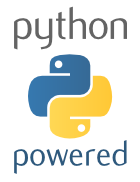
Some time ago instructor Richard Ranson shared with me that he has been doing a fair amount of work with the Python programming language. Based on his suggestion I have started looking into it as well, and I'd like to offer a few general observations to give an overview for anyone wishing to start exploring on their own.
Python is a scripting/programming environment that adheres to a somewhat strict formatting scheme that you must use while coding. Specifically, you must pay attention to consistently indent lines of code that are related, such as code within a loop block, in order to indicate the structure of your script or program. Accepting this restriction allows you to simplify the coding style in that curly brackets and semicolons are no longer necessary as a result.
Since Python is quite popular, a vast number of add-on libraries are available to ease the task of writing a script to perform a specific task. These include anything from simple plotting to libraries that can replicate most of the functions of the Matlab environment. Python can also be used to create standalone programs with a graphical user interface or web-based applications with a client-host configuration.
With so many different libraries available, and different purposes that one might be trying to target it can be bewildering to try and set up your computer to get started. Fortunately, users in the Python community have created "distributions" that are collections of libraries and utilities that are suited for more specific purposes. This is similar to the Linux operating system, where the "kernel" is common among different "distributions" that have various features that appeal to different audiences.
One such distribution that Dr. Ranson had recommended to try is called "Python (x,y)," which is a collection of libraries and utilities that are suited to scientific and engineering applications. Python (x,y) is a fairly large download (~800 MB as of the time of this post), but it does give a very solid starting point for starting to explore the Python language.
Of course, the main site for the Python language offers a great getting started guide for learning about the basics. You might want to quickly jump from there right into the main documentation and specifically the tutorial. I'll be posting more entries on using Python in the near future, so stay tuned!
- Log in to post comments